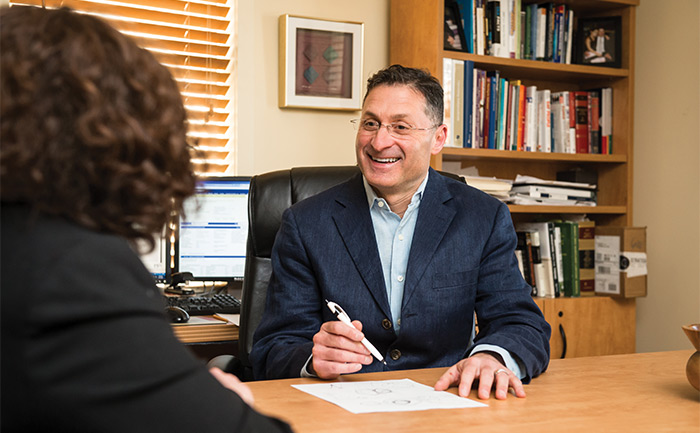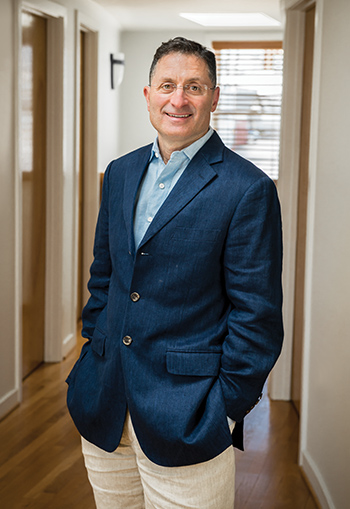Two steps forward
Two steps forward

Greg Gann • Baltimore, MD
Gann Partnership, LLC • LPL Financial
With degrees in philosophy and law, Greg Gann is analytical by nature. His use of active investment management at Gann Partnership, LLC, is rooted in sound logic.
Proactive Advisor Magazine: Greg, tell me about your investment philosophy.
Our mission statement really says it all in a nutshell. We want to grow clients’ wealth by actively analyzing and evaluating the markets to determine where and when to invest. We use a variety of offensive and defensive investment strategies; it is crucial that our strategies have an offensive as well as defensive nature. Part of what we mean by defense is, where appropriate, investing in alternative investments using asset classes beyond traditional stock and bond portfolios.
We—me and highly professional third-party managers—research and vet all types of investments. The key is letting clients know that a qualified professional is monitoring all of the pieces of their portfolios on a regular basis, taking action if need be.
How did you first come to an active-management investment approach? Was there a “light bulb” moment?
Yes, sort of a slow turning-on of the light that ended with the dot-com stock bust of 2001-2002. Before that, I was pretty much following a standard asset-allocation strategy for clients, and, frankly, the research was heavily reliant on what was provided by investment companies on a monthly basis. While there was nothing wrong with the research per se, the investments themselves had very little ability to react to market conditions.
When the bottom fell out of the market, client portfolios took some pretty big hits. I knew then there had to be a better way. My colleagues all had the same experience—a tale of woe—and it was clear this mousetrap wasn’t working. Everybody was getting the same results, and nobody was using active management.
The model used by the industry then was the old pie-chart model, basing things on what might work over a time frame of 25 to 50 years. But not every investor has that kind of time frame.
Over my career, I have seen the real estate market blow up twice and three stock market crashes. I think it is prudent to think those might happen again—and not if, but when.

OK, let’s flash forward. How does that play out today in the investment work you do with clients?
The idea, though maybe not the execution, became obvious to me: The overall investment model, the plan, and the strategy have to take into consideration the current market environment and where risk and opportunities may lie in real time—not a model that is static.
I want to offer clients a model that is value-added, proactive, and differentiated; otherwise, I might as well not hang out my shingle.
So where do you go to execute this approach?
There are a variety of resources that we use. I think investment management is a practice just like any other highly skilled profession, and it is constantly evolving. You need to always hone your skills and seek out the best partners who are on top of new products, tools, and methodologies.
It starts with our broker-dealer, LPL Financial. It offers great resources in terms of research and access to a variety of third-party money managers. I have all of the resources of one of the largest independent broker-dealers at my fingertips—research, technology, and retirement planning—but my practice is small enough to provide the personalized service clients need.
I also seek out independent sources of research, and I am not confined to any one approach. I invest quite a bit in research, both technical and fundamental. It is like putting the pieces of a puzzle together for each client, analyzing his or her specific needs and risk profiles, and then deciding where and when to allocate their portfolio and which third-party managers to use.
Is there a simple analogy you use to explain your approach to clients?
I think of investing like a staircase. What I have found over the years is that when risk is on, when the market is strong, people are climbing the staircase. They’re going up, up, up. They’re happy as they get to the top of the staircase.
But, the market inevitably pulls back. There is a correction, and instead of falling down a step or two or three, they go all the way back down to the landing. Then they climb back up the staircase, forgetting about the fact that they were at the landing not long ago, and when they’re back at the top of the staircase, they fall again. It’s like a yo-yo effect. The 401(k) became a “201(k),” became a 401(k), etc.
I can’t say that they’re never going to fall down some steps, but I want them to be able to get off the staircase just having fallen two or three steps at a time. Then, when the market gives a signal to go back on offense, based on our independent research, hopefully clients are starting from a higher stair level rather than the landing again.
To drill down, what kinds of strategies do you use overall, or specifically for offense or defense?
 Overall, I like to use a noncorrelated approach. Within that, I will use both fundamental and technical, or algorithmic-based, active strategies.
Overall, I like to use a noncorrelated approach. Within that, I will use both fundamental and technical, or algorithmic-based, active strategies.
It’s more of a “core and satellite” approach. In the core, particularly in today’s markets, I feel that far too many folks, 401(k) or otherwise, have too much of their net worth tied into stock and bond funds. In the core, I’m looking for things that don’t necessarily depend on the market to go up in order to have profits, or that are frequently independent of the overall stock or bond market.
I am not afraid to use alternative strategies or asset classes. I am a great believer in income-producing real estate investments as a core strategy, as real estate has created a lot of wealth. But I will also use everything from actively managed equity and bond investments for qualified investors.
I want to balance out market-dependent assets with other assets that can provide buffers from a big downside move. Then we allocate further around that core, usually on a tactical equity and fixed-income basis, again using third-party managers.
Studies have shown that over time if you diversify a portfolio from simple stock and bonds into noncorrelated assets, you do two pretty amazing things: You can potentially reduce risk and you enhance return.
Thanks so much. Any thoughts you would like to close with?
I think my background plays a big role in how I manage money for clients. I have an undergraduate degree in philosophy, a law degree, and a great deal of real estate and business experience. I think all four of these have tended to drive me to question conventional thinking, look to answer what could happen or go wrong, and then prepare extensively for it. This is how I handle the accounts and the trust of my clients.
Disclosure: Securities and advisory services offered through LPL Financial, a registered investment advisor. Member FINRA & SIPC. Gann Partnership, LLC, is not an affiliate company of LPL Financial.
LPL Financial, Inc., disclosure as it relates to Greg Gann: The opinion voiced in this material are for general information only and are not intended to provide specific advice or recommendations for any individual. All performance referenced is historical and is no guarantee of future results. There is no guarantee that a diversified portfolio will enhance overall returns or outperform a non-diversified portfolio. Diversification does not protect against market risk. Investing involves risk including loss of principal.
Photography by Mike Morgan

